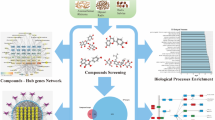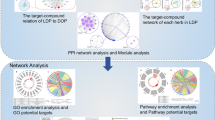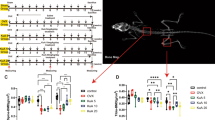Abstract
This experiment was a network pharmacology research based on the theoretical system of traditional Chinese medicine. TCMSP database, PubChem database, RCSB database, and SwissTargetPrediction database were used to study the effective chemical constituents of Ligustri lucidi Fructus and Ecliptae Herba in Erzhiwan, a traditional prescription for nourishing the liver and kidney. Then Genecards database, OMIM database, OMIM Gene Map, and Metascape database were used to study the therapeutic targets of osteoporosis. At last, Cytoscape 3.6.0 software, its built-in Bisogenet and CytoNCA, AutoDockTools-1.5.6 software, PYMOL-2.2.0 software, and Gromacs software, by drawing the relationship diagram between chemical components and disease targets, PPI network of disease, semi-flexible molecular docking technology, evaluation and analysis of enrichment pathway, and molecular dynamics simulation, were used to study the therapeutic mechanism of Erzhiwan on osteoporosis. It is found that the intervention and regulation of Erzhiwan on osteoporosis were mainly realized through multiple targets of active ingredients and multiple pathways, which provided support for the continued development of Erzhiwan.












Similar content being viewed by others
Data availability
N/A. All data generated or analyzed during this study were included in this published article.
Code availability
N/A.
References
Zhang D, Sun L, Mao B et al (2021) Analysis of chemical variations between raw and wine-processed Ligustri Lucidi Fructus by ultra-high-performance liquid chromatography-Q-Exactive Orbitrap/MS combined with multivariate statistical analysis approach[J]. Biomed Chromatogr 35(4):e5025
Zhao H, Cheng S, Zhang L et al (2019) Ultra-high-pressure-assisted extraction of wedelolactone and isodemethylwedelolactone from Ecliptae Herba and purification by high-speed counter-current chromatography[J]. Biomed Chromatogr 33(6):e4497
Zhai Y, Xu J, Feng L et al (2019) Broad range metabolomics coupled with network analysis for explaining possible mechanisms of Er-Zhi-Wan in treating liver-kidney Yin deficiency syndrome of Traditional Chinese medicine[J]. J Ethnopharmacol 234:57–66
Yao W, Gu H, Zhu J et al (2014) Integrated plasma and urine metabolomics coupled with HPLC/QTOF-MS and chemometric analysis on potential biomarkers in liver injury and hepatoprotective effects of Er-Zhi-Wan[J]. Anal Bioanal Chem 406(28):7367–7378
Yan B, Cai X, Yao W et al (2012) Experimental study of active ingredients group in liver protection from erzhi wan on acute hepatic injury induced by CCl4 in mice][J. Zhongguo Zhong Yao Za Zhi 37(9):1303–1306
Wan XM, Zhang M, Zhang P et al (2016) Jiawei Erzhiwan improves menopausal metabolic syndrome by enhancing insulin secretion in pancreatic beta cells[J]. Chin J Nat Med 14(11):823–834
Sun W, Wang YQ, Yan Q et al (2014) Effects of Er-Zhi-Wan on microarchitecture and regulation of Wnt/beta-catenin signaling pathway in alveolar bone of ovariectomized rats[J]. J Huazhong Univ Sci Technolog Med Sci 34(1):114–119
Cao X, Li H, Wang M et al (2020) Analysis of five active ingredients of Er-Zhi-Wan, a traditional Chinese medicine water-honeyed pill, using the biopharmaceutics classification system[J]. Biomed Chromatogr 34(2):e4757
Jia L, Fu L, Wang X, Yang W, Wang H, Zuo T, Zhang C, Hu Y, Gao X, Han L (2018) Systematic profiling of the multicomponents and authentication of Erzhi Pill by UHPLC/Q-Orbitrap-MS oriented rapid polarity-switching data-dependent acquisition and selective monitoring of the chemical markers deduced from fingerprint analysis. Molecules 23(12):3143–3156
Chotiyarnwong P, McCloskey EV (2020) Pathogenesis of glucocorticoid-induced osteoporosis and options for treatment[J]. Nat Rev Endocrinol 16(8):437–447
Vidal C, Bermeo S, Fatkin D et al (2012) Role of the nuclear envelope in the pathogenesis of age-related bone loss and osteoporosis[J]. Bonekey Rep 1:62
Yang DH, Yang MY (2019) The role of macrophage in the pathogenesis of osteoporosis. Int J Mol Sci 20(9):2093–2107
Tawornchat P, Pattarakankul T, Palaga T et al (2021) Polymerized luteolin nanoparticles: synthesis, structure elucidation, and anti-inflammatory activity[J]. ACS Omega 6(4):2846–2855
Nabavi SF, Braidy N, Gortzi O et al (2015) Luteolin as an anti-inflammatory and neuroprotective agent: a brief review[J]. Brain Res Bull 119(Pt A):1–11
Jang TY, Jung AY, Kyung TS et al (2017) Anti-allergic effect of luteolin in mice with allergic asthma and rhinitis[J]. Cent Eur J Immunol 42(1):24–29
Adachi SI, Oyama M, Kondo S et al (2021) Comparative effects of quercetin, luteolin, apigenin and their related polyphenols on uric acid production in cultured hepatocytes and suppression of purine bodies-induced hyperuricemia by rutin in mice[J]. Cytotechnology 73(3):343–351
Jiang ZB, Wang WJ, Xu C et al (2021) Luteolin and its derivative apigenin suppress the inducible PD-L1 expression to improve anti-tumor immunity in KRAS-mutant lung cancer[J]. Cancer Lett 515:36–48
Ashrafizadeh M, Ahmadi Z, Farkhondeh T et al (2020) Autophagy regulation using luteolin: new insight into its anti-tumor activity[J]. Cancer Cell Int 20(1):537
Zhu JX, Wen L, Zhong WJ et al (2018) Quercetin, kaempferol and isorhamnetin in Elaeagnus pungens thumb. Leaf: Pharmacological Activities and Quantitative Determination Studies[J]. Chem Biodivers 15(8):e1800129
Dabeek WM, Marra MV (2019) Dietary quercetin and kaempferol: bioavailability and potential cardiovascular-related bioactivity in humans. Nutrients 11(10):2288–2306
Ferenczyova K, Kalocayova B, Kindernay L, Jelemensky M, Balis P, Berenyiova A, Zemancikova A, Farkasova V, Sykora M, Tothova L, Jasenovec T, Radosinska J, Torok J, Cacanyiova S, Barancik M, Bartekova M (2020) Quercetin exerts age-dependent beneficial effects on blood pressure and vascular function, but is inefficient in preventing myocardial ischemia-reperfusion injury in zucker diabetic fatty rats. Molecules 25(1):187–207
Chekalina N, Burmak Y, Petrov Y et al (2018) Quercetin reduces the transcriptional activity of NF-kB in stable coronary artery disease[J]. Indian Heart J 70(5):593–597
Duan J, Guan Y, Mu F et al (2017) Protective effect of butin against ischemia/reperfusion-induced myocardial injury in diabetic mice: involvement of the AMPK/GSK-3beta/Nrf2 signaling pathway[J]. Sci Rep 7:41491
Zhao HM, Zhang XY, Lu XY et al (2018) Erzhi Pill((R)) protected experimental liver injury against apoptosis via the PI3K/Akt/Raptor/Rictor Pathway[J]. Front Pharmacol 9:283
Jiang J, Yin J, Liu X et al (2018) Erzhi formula extracts reverse renal injury in diabetic nephropathy rats by protecting the renal podocytes[J]. Evid Based Complement Alternat Med 2018:1741924
Desai AV, Robinson GW, Gauvain K, Basu EM, Macy ME, Maese L, Whipple NS, Sabnis AJ, Foster JH, Shusterman S, Yoon J, Weiss BD, Abdelbaki MS, Armstrong AE, Cash T, Pratilas CA, Corradini N, Marshall LV, Farid-Kapadia M, Chohan S, Devlin C, Meneses-Lorente G, Cardenas A, Hutchinson KE, Bergthold G, Caron H, Maneval EC, Gajjar A, Fox E (2022) Entrectinib in children and young adults with solid or primary CNS tumors harboring NTRK, ROS1 or ALK aberrations (STARTRK-NG). Neuro Oncol 24(10):1776–1789
Shu J, Li J, Fu Y et al (2020) Association of ESR1 polymorphism rs2234693 and rs9340799 with postmenopausal osteoporosis in a Chinese population[J]. BMC Musculoskelet Disord 21(1):346
Xiang D, He J, Jiang T (2018) The correlation between estrogen receptor gene polymorphism and osteoporosis in Han Chinese women[J]. Eur Rev Med Pharmacol Sci 22(23):8084–8090
Garcia-Rojas MD, Palma-Cordero G, Martinez-Ramirez CO et al (2022) Association of polymorphisms in estrogen receptor genes (ESR1 and ESR2) with osteoporosis and fracture-involvement of comorbidities and epistasis[J]. DNA Cell Biol 41(4):437–446
Hidalgo-Bravo A, Parra-Torres AY, Casas-Avila L et al (2019) Association of RMND1/CCDC170-ESR1 single nucleotide polymorphisms with hip fracture and osteoporosis in postmenopausal women[J]. Climacteric 22(1):97–104
Masaki H, Imanishi Y, Naka H et al (2020) Bazedoxifene improves renal function and increases renal phosphate excretion in patients with postmenopausal osteoporosis[J]. J Bone Miner Metab 38(3):405–411
Wang S, Ma Q, Xie Z et al (2021) An antioxidant sesquiterpene inhibits osteoclastogenesis via blocking IPMK/TRAF6 and counteracts OVX-induced osteoporosis in mice[J]. J Bone Miner Res 36(9):1850–1865
Recine F, De Vita A, Fausti V et al (2021) Case report: adult NTRK-rearranged spindle cell neoplasm: early tumor shrinkage in a case with bone and visceral metastases treated with targeted therapy[J]. Front Oncol 11:740676
Park S, Zhao Y, Yoon S et al (2011) Repressor of estrogen receptor activity (REA) is essential for mammary gland morphogenesis and functional activities: studies in conditional knockout mice[J]. Endocrinology 152(11):4336–4349
Zhang Y, Liu H, Zhang C et al (2015) Endochondral ossification pathway genes and postmenopausal osteoporosis: association and specific allele related serum bone sialoprotein levels in Han Chinese[J]. Sci Rep 5:16783
Yu B, Huo L, Liu Y et al (2018) PGC-1alpha controls skeletal stem cell fate and bone-fat balance in osteoporosis and skeletal aging by inducing TAZ[J]. Cell Stem Cell 23(2):193–209
Suttamanatwong S (2017) MicroRNAs in bone development and their diagnostic and therapeutic potentials in osteoporosis[J]. Connect Tissue Res 58(1):90–102
Geng Q, Gao H, Yang R et al (2019) Pyrroloquinoline quinone prevents estrogen deficiency-induced osteoporosis by inhibiting oxidative stress and osteocyte senescence[J]. Int J Biol Sci 15(1):58–68
La Fleur L, Falk-Sorqvist E, Smeds P et al (2019) Mutation patterns in a population-based non-small cell lung cancer cohort and prognostic impact of concomitant mutations in KRAS and TP53 or STK11[J]. Lung Cancer 130:50–58
Jia F, Sun R, Li J et al (2016) Interactions of Pri-miRNA-34b/c and TP53 polymorphisms on the risk of osteoporosis[J]. Genet Test Mol Biomarkers 20(7):398–401
Funding
This study was supported by the Henan Science and Technology Research Project (212400410206) and the Cadre Teacher Training Program of the Sanquan College of Xinxiang Medical University (SQ2021GGJS06).
Author information
Authors and Affiliations
Contributions
Yanling Li and Weijuan Han were responsible for designing the project and obtaining funds; Ziliang Li, Tongsheng Ye, and Fuqi Hao were responsible for data collation and statistical analysis; Yichi Wang and Wenqian Li carried out the molecular dynamics simulation experiments; Qingfeng Yan and Huawei Shi prepared the first draft. All authors had read and approved the final manuscript.
Corresponding author
Ethics declarations
Competing interests
The authors declare no competing interests.
Conflict of interest
The authors declare no competing interests.
Additional information
Publisher's note
Springer Nature remains neutral with regard to jurisdictional claims in published maps and institutional affiliations.
Rights and permissions
Springer Nature or its licensor (e.g. a society or other partner) holds exclusive rights to this article under a publishing agreement with the author(s) or other rightsholder(s); author self-archiving of the accepted manuscript version of this article is solely governed by the terms of such publishing agreement and applicable law.
About this article
Cite this article
Li, Y., Li, Z., Ye, T. et al. Mechanism of Erzhiwan in treating osteoporosis based on molecular docking technology and molecular dynamics simulation. J Mol Model 29, 21 (2023). https://doi.org/10.1007/s00894-022-05418-y
Received:
Accepted:
Published:
DOI: https://doi.org/10.1007/s00894-022-05418-y




